Developed in the center East and Egypt on hardstone, copper wheel inscribing survived as a craft in seventeenth century Bohemia and Dresden on glass. It was made use of for a variety of purposes, consisting of showing the imperial double-headed eagle (Reichsadlerhumpen) and allegorical styles.
Engravers of this duration progressively abandoned direct quality in favour of crosshatched chiaroscuro results. A few engravers, such as Schongauer and Mantegna, dealt with glass with a sculptural sensation.
Ancient Art
By the end of the 17th century, nevertheless, diamond-point inscription was being supplanted by wheel inscription. Two noteworthy engravers of this period are worth mention: Schongauer, who raised the art of glass engraving to match that of painting with works like Saint Anthony Tortured by Demons, and Mantegna, who shaded his illustrations with brief jotted lines of varying size (fig. 4) to attain chiaroscuro effects.
Other Nuremberg engravers of this time included Paul Eder, who mastered fragile and little landscapes, and Heinrich Schwanhardt, who engraved inscriptions of great calligraphic top quality. He and his boy Heinrich also developed the method of engraving glass with hydrofluoric acid to produce an impact that appeared like glass covered in ice. The engraved surface could after that be reduced and inscribed with a copper-wheel. This approach is employed on the rock-crystal ewer revealed here, which combines deep cutting, copper-wheel engraving and polishing. Recognizing the inscribing on such pieces can be hard.
Venetian Glass
When Venice was a European power, Venetian glassmakers took the lead in many high value-added industries. Unlike textiles and fashion, glassmaking retained a legacy of sophisticated techniques. It likewise brought seeds of the ornamental magnificence symbolized in Islamic art.
Nevertheless, Venetian glassmakers were not excited to share these concepts with the remainder of Europe. They maintained their artisans cloistered on the island of Murano so they would certainly not be affected by brand-new patterns.
Despite the fact that need for their item ups and downs as tastes altered and rival glassmakers emerged, they never lost their appeal to wealthy patrons of the arts. It is therefore no surprise that inscribed Venetian glass shows up in countless study in still life paints as a sign of high-end. Commonly, a master treasure cutter (diatretarius) would cut and decorate a vessel originally cast or blown by an additional glassworker (vitrearius). This was a pricey venture that needed terrific skill, patience, and time to produce such thorough job.
Bohemian Glass
In the 16th century, Bohemian glassmakers adjusted the Venetian recipe to their own, developing a much thicker, more clear glass. This made it much easier for gem-cutter to carve in the same way they carved rock crystal. On top of that, they created a technique of cutting that allowed them to make really in-depth patterns in their glasses.
This was complied with by the production of tinted personalized housewarming gifts glass-- blue with cobalt, red with copper and light environment-friendly with iron. This glass was prominent north of the Alps. Additionally, the slender barrel-shaped cups (Krautstrunk) were likewise popular.
Ludwig Moser opened up a glass style studio in 1857 and was successful at the Vienna International Event of 1873. He established a totally integrated manufacturing facility, using glass blowing, polishing and inscribing. Up until the end of The second world war, his company dominated the marketplace of personalized Bohemian crystal.
Modern Craft
Engraving is just one of the earliest hand-icraft methods of attractive improvement for glass. It demands a high degree of precision along with a creative imagination to be reliable. Engravers need to also have a feeling of structure in order to tastefully combine glossy and matte surface areas of the cut glass.
The art of engraving is still alive and flourishing. Modern methods like laser engraving can attain a greater degree of information with a higher speed and accuracy. Laser modern technology is additionally able to create designs that are much less prone to cracking or fracturing.
Engraving can be utilized for both industrial and ornamental purposes. It's prominent for logos and trademarks, as well as ornamental embellishments for glasses. It's also a prominent way to add individual messages or a champion's name to prizes. It is very important to note that this is a hazardous task, so you must constantly utilize the ideal security tools like goggles and a respirator mask.
